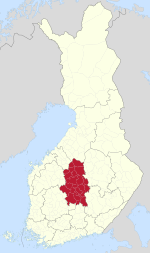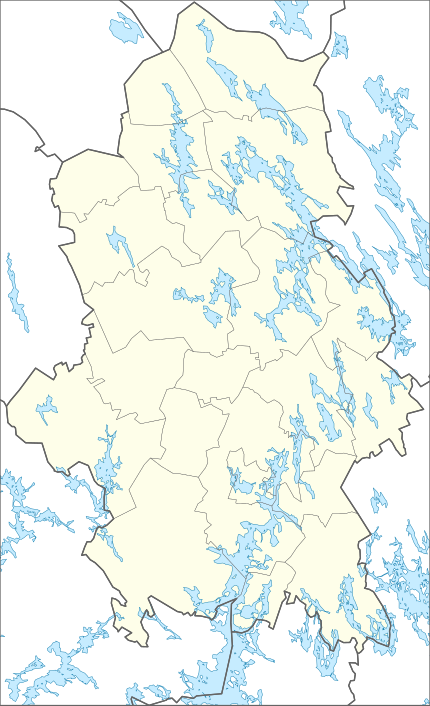Central Finland
| |
|---|---|
| Region of Central Finland Keski-Suomen maakunta Landskapet Mellersta Finland | |
 Central Finland on a map of Finland | |
| Coordinates: 62°30′N 025°30′E / 62.500°N 25.500°E | |
| Country | Finland |
| Historical province | Tavastia, Satakunta |
| Capital | Jyväskylä |
| Area | |
| • Total | 19,950.38 km2 (7,702.88 sq mi) |
| Population (2019) | |
| • Total | 275,104 |
| • Density | 14/km2 (36/sq mi) |
| GDP | |
| • Total | €8.725 billion (2015) |
| • Per capita | €31,662 (2015) |
| Time zone | UTC+2 (EET) |
| • Summer (DST) | UTC+3 (EEST) |
| ISO 3166 code | FI-08 |
| NUTS | 193 |
| Regional animal | Tundra hare (Lepus timidus) |
| Regional bird | Capercaillie (Tetrao urogallus) |
| Regional fish | Lake trout (Salmo trutta lacustris) |
| Regional flower | Oxeye daisy (Leucanthemum vulgare) |
| Regional stone | Diorite |
| Regional lake | Lake Keitele |
| Website | keskisuomi.fi |
Central Finland (Finnish: Keski-Suomi; Swedish: Mellersta Finland) is a region (maakunta / landskap) in Finland. It borders the regions of Päijät-Häme, Pirkanmaa, South Ostrobothnia, Central Ostrobothnia, North Ostrobothnia, North Savo, and South Savo. The city of Jyväskylä is the regional centre and by far the largest city in the area. The Central Finland lies slightly south of the geographical centre of Finland. The landscape is hilly and a large part of the province belongs to the Finnish Lakeland.[2]

The largest lake in the very water-based region is Lake Päijänne (1,080 km2). Other large lakes are Lake Keitele (490 km2), Lake Konnevesi (190 km2) and Lake Kivijärvi (150 km2). The highest point in the region is Kiiskilänmäki in the municipality of Multia, which reaches an altitude of 269 meters above sea level.[4] Kuokanjoki, Finland's shortest river and one of the world's shortest rivers is in the region.[5][6]
Central Finland has been one of the slowly growing regions in terms of population, but the growth has been based on the Jyväskylä sub-region's position as a significant growth center, and most of the region's municipalities are declining in population.[7][8] Also, of these, Kyyjärvi has landed on the Finnish state's crisis financial management list due to its economic hardship.[9][10] Luhanka, the smallest municipality in the whole Mainland Finland in terms of population, is also located in the region.[11][12]

























